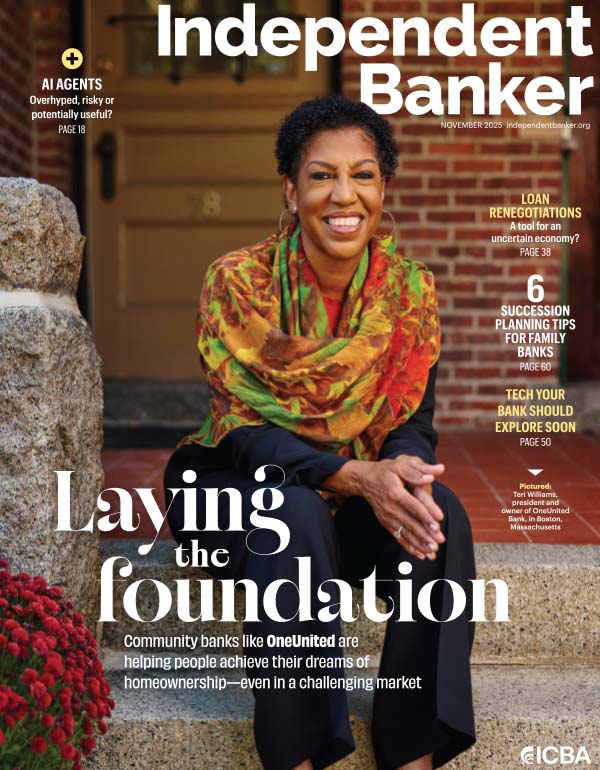Making a list, checking it twice
Oct. 21, 2025
Year end is approaching. Here are some seasonal reminders
Since we started seeing Halloween decorations in August, I felt it was high time we started thinking about the Holiday season. More specifically, as it relates to community banking. And still more specifically, about a checklist for the balance sheet. There are some seasonal items that bear attention prior to, and immediately after, year end. So let’s take a look at what may be on the radar for the fourth quarter.
Gain/loss harvesting
I have the same access to industry-wide bank performance reports that any of you do, and I also make it a point of asking bankers how their years are going while traveling the country. The numbers and the commentary have been in sync this year, which isn’t always the case. It sure looks like 2025 is going to conclude favorably for community banks in general. By extension, that means a lot of you are going to be ahead of budget.
That happy dynamic will naturally lead management teams to consider options for fine tuning their earnings. There are some current variables that give bankers a lot of flexibility in timing their income recognition. For example, the average bond portfolio has a market loss of about 5%, which is the lowest percentage since March 2022. This means that some individual positions have gains, and some have losses. So there are probably some combinations of sale candidates that can produce the desired amount of realized income/loss. A friendly reminder: if your bank is looking for gains, make sure they are not from tax-free bonds. This brings up a related activity…
SBA secondary market
The Small Business Administration’s flagship 7(a) program set a record of $37 billion of closed loans in fiscal 2025. This means more banks have more SBA product in their loan portfolios than ever, and the guaranteed portions (usually 75%) are probably the most liquid loans on a bank’s balance sheet. They can quickly be sold to one of the consortium of SBA poolers at substantial gains. Because the guarantees are always going to demand a premium in the secondary market (due to their full-faith-and-credit status and floating rate structure), many sellers will wait until the fourth quarter to sell, when the bank’s annual earnings are coming into focus.
Inside scoop: the poolers are usually besieged with bid lists as the last quarter progresses, so most reduce their bids to smooth out their purchase commitments. Some years it takes until February for market indigestion to subside. So the suggestion here is to sell your 7(a) loans as they’re closed to more efficiently capture the gains. Don’t wait until December.
Risk management
Bankers know intuitively that best practices for risk management include regular assessment of projected cash flows, collateral positions, alternative funding sources, and contingency funding plans. What may have changed in the last six months is the increased possibility of a lower interest rate environment for next year. Depending on a given bank’s asset/liability posture and its bond holdings, it could mean additional, and perhaps unwelcome, cash flows. A silver lining is that the average bank now owns its bonds at an average price slightly below par (99.86), so prepayments and calls should have little immediate impact on yields. There have been times in this decade when the average book price was nearly 103.00.
Housekeeping
The ever-popular policy reviews are coming up on the tickler file also. Examiners are wont to ask how recently your troika of policies (i.e., investment, interest rate risk, and liquidity) have been updated. Lately the liquidity policy has gotten a lot of scrutiny as community bankers have told me. The good news is that there has been no significant literature from the regulators this year that would require a major re-write. Your brokers and/or A/L modelers should be able to provide some templates, guidance and assistance if necessary.
While you’re getting your board of directors to sign off on updated policies, management should ensure these items are fully documented:
- Approved broker-dealers
- Full list of vendors (with SOC-2 audits if applicable
- Director onboarding and continuing education
- Minutes of committee and full board meetings
- Execution of risk management strategies, such as interest rate swaps or loan sales
- Rationale for, and economics of, bond swaps, with back testing if appropriate
There you have an end-of-year checklist, just in case you’ve forgotten or run out of to-do’s. Again, thanks to the favorable economic backdrop for most regions of the country this year, and to the careful stewardship by most community bank management teams, there don’t seem to be any dumpster fires to fight this year. I will update this column with some ideas on how to launch a successful 2026 as soon as I start seeing Easter decorations. Happy Holidays!


